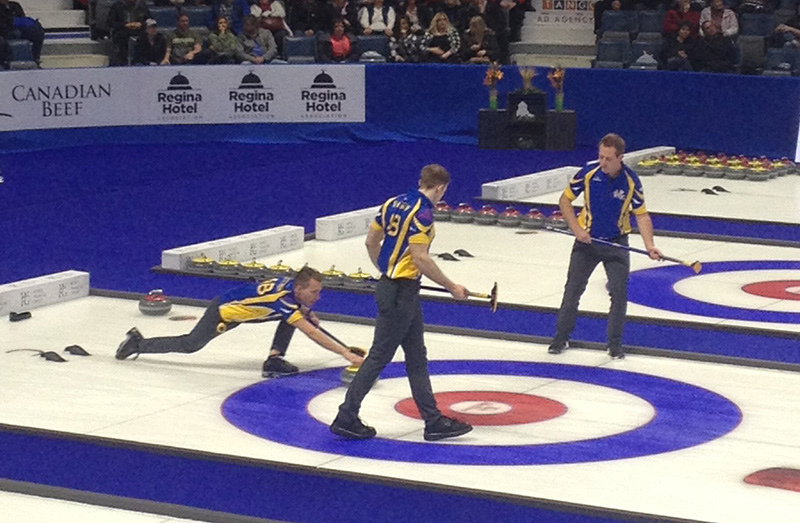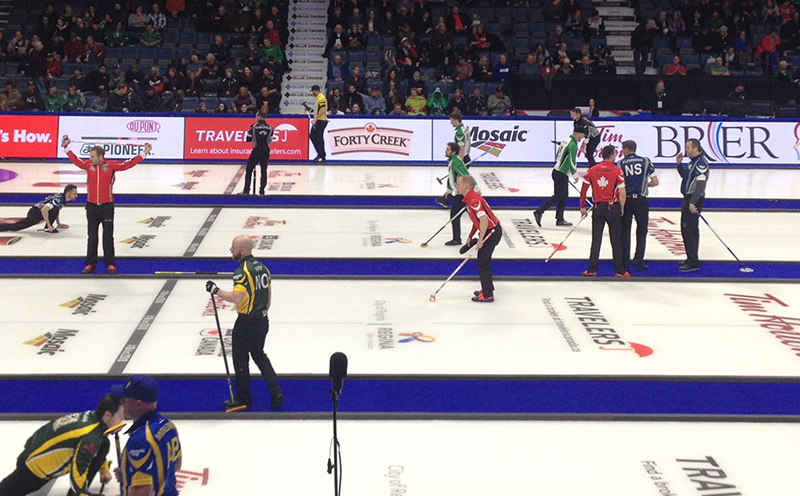“There’s nothing like your first Brier.” — Al Cameron, communications and media relations, Curling Canada
Adorned in fleece-lined boots salvaged from my closet depths and a parka with broken zipper, I trudged through the snow from the recent blizzard to Regina’s Brandt Centre. Having dedicated my focus to my footing, I realized my trajectory had left me stuck on the south (wrong) side of Saskatchewan Drive, a main thoroughfare running east-west along Regina’s north end.
I took stock of the barren street and spotted a man and his dog ambling with confident calm.
“Excuse me, what’s the best way to get to that intersection?” I pointed to the now sunken road on the other side of a chain link fence, marked with a metal statue of a stegosaurus.
“Ah, goin’ for the curling.”
Sure was. The man looked slightly amused and asked where I was from.
Yep, all the way from Vancouver. He smiled, his face suggesting he believed that I was indeed standing on this here snowbank in my jacket that didn’t zip up, adrift all the way from the Pacific Coast.
He offered two directions and then a simpler solution. “Third option: in 10 minutes when I’m done walking my mutt I can drive you over in my truck.”
I’d made it. The first person I’d encountered was sincerely trying to get me to my Brier as soon as possible. I had no qualms as to the sincerity of his intent but was determined to traverse the geography on foot. He bid me on my way.
“Enjoy the games.”
Vortex: Canadiana
This anomalous occasion, completely counterintuitive to anything I would normally find myself compelled to do, was a family gathering of sorts motivated by the spirit of my uncle and the annual tradition he loved. An avid curling fan, he’d been travelling to the Brier from his home in Hope, B.C. since his retirement, until his sudden passing in January denied him the opportunity to take his seat.
At some point it had become a ritual for him and my father, and my aunt had joined the sibling congregation a few odd years. This time my uncle’s two daughters and niece were going too, and while I’d previously considered attending, it was ultimately the circumstances of loss and its shared familial kindred that found me heading to the middle of the prairies in winter, to a province I’ve only driven through, right into the vortex of a Canadian stereotype.
It even said Tim Hortons on the tickets.
As the day of my flight approached — and the destination temperature continued to hover around minus -15 C — I began to feel a novel enthusiasm for the endeavour, as well as its sociological exposé: How do we mediate our own identity when our boots are laced to embrace the caricatures of our own culture?
And so I arrived at the Brandt Centre, 2018’s home to Canada’s men’s curling championship, halfway through the second end. As I entered the arena I felt my uncle playfully joust at my tardiness — the second end! He of course, would never arrive late.
I soon realized my misstep in passing up the preamble. Besides missing the opening end (of which there are 10), I also missed the novel and yet odd tradition of singing the national anthem before any major sporting event; the practice slides of the various teams stitching themselves in alternate directions on the four sheets of ice; and the pre-game blackout for a two-minute promo reel that strived to advertise curling with the speed and tumult of hockey. All the while the Brier mascot, a curling rock named Slider, paraded around the ice flaunting the exaggerated mannerisms that mascots do. By day two I’d decided this ritual assemblage was indispensable.
Eyes on the house
As a fledgling curling enthusiast, I watched the colour-coded rocks thrown in alternation and anticipated the winner to be the one closest to the centre, where a perfect draw aimed at the so-called “button” would leave the Tim Hortons logo completely obscured. I knew the bigger rings beyond that were the house, but the finer points of the game had to be explained to me by my cousins as the days went on, and I learned a little more draw by draw.
It took a fair amount of googling to discover that my aunt’s explanation of the slide employed by Team Wild Card, the team from Manitoba added to the tournament to keep the Brier dynamic, was the “Manitoba tuck,” not “Manitoba tech.”
I collected a bit of history, too. All the iconic names at the Brier initially appeared puzzling, yet ultimately followed a single thread back to the original sponsors. They were emblematic affiliations that said as much about sponsorship as they did about the staple luxuries of the small-town, working class fans who built the Brier: the Purple Heart, the Tankard, the Patch and the Brier itself.
The name of the tournament came from Macdonald Tobacco, the Brier’s first major sponsor, which sold a pipe tobacco by that name. A Purple Heart was embossed in the brand’s tobacco plugs, and carried over to the heart-shaped patches worn by competitors. Macdonald sponsored the Brier for just over 50 years, from the first Brier in 1927 until the end of the ’70s.
The Tankard, like the Stanley and Grey Cup, was made to hold the celebratory drink of the victorious and corporately refashioned when Labatt took over primary sponsorship in 1980. And so we find ourselves at the coffee cups that mark the ice: Tim Hortons has held the role of primary sponsor since 2005.
The entire day took place in the arena. I’d found a coffee shop with exceptional Oreo scones and other junk food-laced baked goods that was my morning pit stop, but from then on I was at The Centre.
Into the Brier Patch
Between plugging the event sponsors, the video panel surrounding the ice advertised the “Short Indoor Walk” to the (Brier) Patch: the place to be after the final rock was cast. (Amusingly also the name of one of Regina’s cornerstones of independent journalism, Briarpatch magazine, and a region in the Star Trek universe.)
But the source of this nomenclature was a little more elusive, merely traceable to my faint childhood memories of Brer Rabbit. As the story goes, the clever Brer Rabbit, caught by Brer Fox, pleads not to be thrown into the brier patch while he knows fair well that the thicket is the place for a rabbit to be… safe and protected in his habitat with the other most esteemed rabbits.
And so, the mass exodus from the arena following the draws travelled through the corridors where prime real estate was taken up by displays from Regina’s major hosting sponsor, Mosaic — North America’s fertilizer mastodon and the continent’s biggest potash producer — and large-scale industrial agriculture equipment manufacturer New Holland. Big-business prairie sponsors charmingly offset by the humble elderly man in the corner of the thoroughfare, offering a meticulously arranged table of pins from decades of bonspiels, available exclusively for trade.
Beyond this, and following a sharp left hand turn at the Tim Hortons coffee truck doling out free double-doubles, one arrived at the gymnasium-style room that held the taco-in-a-bag purveyor and beer kiosks. This was the glorified house party of the curling enthusiast, the Brier Patch. By championship weekend, I was pretty sure that was me.
Retrofitting a family pastime
Following the buzz around the retirement of the Sedin brothers from the Vancouver Canucks, a handful of friends exchanged comments on the oddity of two siblings simultaneously being professional hockey players. While every sport seemingly has its examples, curling takes it to a different echelon.
Curling teams evolved from a small-town ethos: you and your best friends hit the local arena and became a curling team. This often ended up meaning you curled with your brother, sister or cousin. The Koe brothers are prime examples, with Kevin Koe skipping Alberta in most Briers since 2010 as well as this year’s Olympics in PyeongChang and his brother, Jamie Koe, skipping the Northwest Territories for most of the 2000s. Their sister, Kerry Galusha, has skipped the Northwest Territories at the Scotties Tournament of Hearts (the women’s equivalent of the Brier) for over a decade. Retired Alberta skip Kevin Martin’s son Karrick Martin played lead for this year’s new young Alberta hopefuls, skipped by Brendan Bottcher. And the list of relatives that competed in this year’s Brier didn’t end there: Northern Ontario had brothers E.J. and Ryan Harnden, Manitoba Wild Card had Denni and B.J. Neufeld (coached by their father Chris), and Saskatchewan had Kirk and Dallan Muyres, with their father as alternate.
It’s a sport nurtured by the proximity of family, and as I sat in the stands with my aunt and three cousins I realized that this world I expected to find merely novel had succeeded in enamouring me. My criticisms and observances as an outsider diminished as I became persuaded by the unanimous simplicity of its enthusiastic embrace. The values and lifestyle norms that defined the average Brier-goer were a glaring departure from mine, but that didn’t matter as long as I refrained from protesting outside the Mosaic booth. As long as I allied with the pin trader, I was charmed to feel the sentiment that existed in me somewhere: the kid who played cards with three generations on long summer nights, that spent afternoons endlessly sorting buttons in my Oma’s sewing room before an evening game of sjoelbak, who never got to go fishing but still ate the fish.

And so as a long-term West Coast émigré originally born in Edmonton, I found myself robustly cheering for Team Alberta. Perhaps I was hoisted by my uncle’s and father’s Spirit River childhood, carried forth by the distinct lexicon and phrasings that emerged every time they shared a room.
To be fair, B.C. didn’t make it very far. The prairie cities host the Brier an average two out of every three years, but the Brier is held in B.C. about as infrequently as the province wins — they secured their last gold in 2000, and the Brier has only been held in B.C. once since.
Out of the Purple Heart of the Prairies
I had booked my flight home on the night of the final draw, predicting before my trip that I couldn’t possibly be invested in who actually won the Brier. And so I found myself on my WestJet flight back to Vancouver passing on the complimentary beverage but using the opportunity to ask the flight attendant if there were just the two sports channels… the one streaming nothing and the one streaming tennis. She explained yes, but sometimes with bigger events there would be additional streaming.
“Well, I was trying to watch the Brier. It’s the championship final.”
“Oh, yes that’s a big deal isn’t it?”
Yes, yes it is. And it’s my inaugural year. ![]()
Read more: Travel
















Tyee Commenting Guidelines
Comments that violate guidelines risk being deleted, and violations may result in a temporary or permanent user ban. Maintain the spirit of good conversation to stay in the discussion.
*Please note The Tyee is not a forum for spreading misinformation about COVID-19, denying its existence or minimizing its risk to public health.
Do:
Do not: